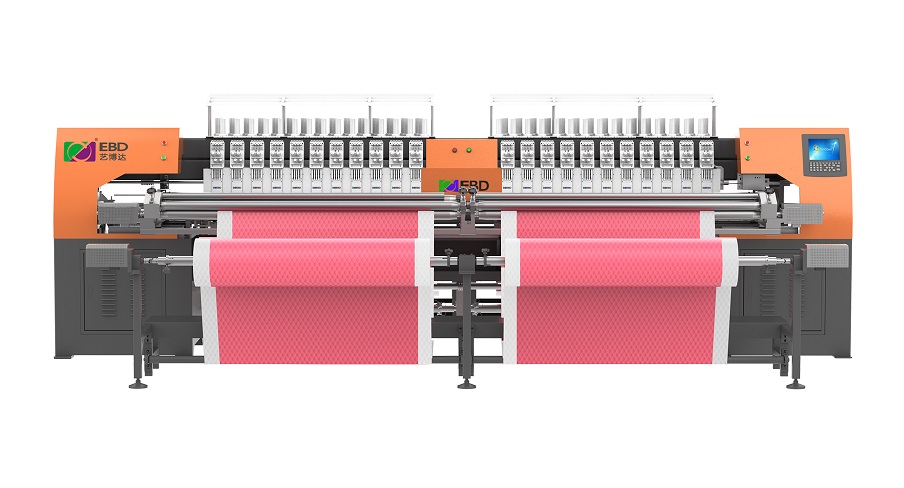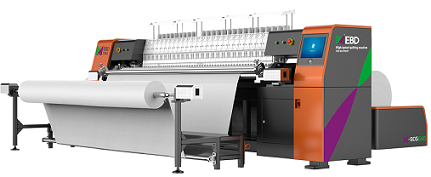Views: 0 Author: Site Editor Publish Time: 2025-03-17 Origin: Site








Choosing the right machine is crucial for successful quilting and sewing projects. But what's the difference between a sewing machine and a quilting machine? Understanding these differences can make or break your project, whether you're a beginner or an experienced sewist. In this post, we’ll explore the key distinctions, helping you choose the best machine for your needs.
Sewing machines are versatile for everyday tasks, while quilting machines are specially designed to handle thicker fabrics, larger projects, and provide precision for intricate quilting designs.
A sewing machine is a versatile tool used for stitching fabrics together. It's essential for many everyday tasks like creating clothes, making home decor, and even crafting.
Common Uses of a Sewing Machine
Stitching garments, home decor items (curtains, pillows), and accessories (bags, wallets).
Embellishing fabrics with decorative stitching or simple repairs.
Types of Sewing Machines
Mechanical: Operates using mechanical components. Simple to use, no electronics required.
Electronic: Offers more features than mechanical models. Has an electronic control system for better precision.
Computerized: Uses a computer to control the machine. Can do more complex stitching patterns, often with touchscreens and automatic settings.
A quilting machine is designed specifically for quilting. Quilting involves stitching together multiple layers of fabric, and a quilting machine makes this process easier and faster.
Specialized Function of a Quilting Machine
It’s equipped to handle thicker, heavier fabrics and multiple layers at once.
Designed to make long, straight, or free-motion stitches to complete quilt designs.
Quilting-Specific Features
Larger Throat Space: Provides more room to maneuver bulky quilts.
Extension Table: Helps to expand the workspace for large projects.
High-Speed Motor: Enables faster sewing speeds, allowing quilters to finish large projects more efficiently.
These features make quilting machines the go-to choice for any serious quilting project.

The key differences between a sewing machine and a quilting machine are essential to know when selecting the right tool for your projects. Sewing machines are perfect for basic tasks with lighter fabrics, while quilting machines offer larger workspaces, higher speeds, and specialized features for larger, heavier quilting projects.
Sewing Machine
A sewing machine typically has a smaller throat area, making it perfect for basic sewing tasks like garments or home decor projects. It's a good fit for lightweight fabrics and small-scale projects.
Quilting Machine
Quilting machines come with a larger workspace, specifically designed to handle the bulk of quilt layers. The throat space is much bigger, providing more room for maneuvering heavy, layered fabrics. This added space is essential for completing large quilts with ease.
Sewing Machine
Some sewing machines may have an extension table, but it's not always included. Without it, the workspace can be cramped, limiting your ability to handle larger projects comfortably.
Quilting Machine
Quilting machines often come with an extension table, allowing more room for bulky quilt pieces. The extra space helps maintain fabric control, making quilting smoother and more efficient, especially for larger designs.
Sewing Machine
Standard sewing machines have slower speeds, typically around 800-1,000 stitches per minute. While sufficient for smaller tasks, they may struggle with heavy or multiple layers of fabric, leading to slower sewing times and less stability.
Quilting Machine
Quilting machines are built for speed, often reaching up to 1600 stitches per minute. These machines are designed with greater stability to handle high-speed stitching without losing precision. This makes them ideal for quilting large projects quickly and efficiently.
Sewing Machine
Sewing machines usually come with basic feet like the presser foot, zipper foot, or buttonhole foot. These are sufficient for basic sewing, but may not provide the precision needed for quilting.
Quilting Machine
Quilting machines come with specialized feet such as the quarter-inch foot, free-motion foot, and walking foot. These feet help quilters achieve more accurate seams, better fabric movement, and reduced puckering. With the right feet, quilting becomes faster, easier, and more precise.
When it comes to stitching capabilities, sewing machines offer basic utility stitches suitable for simple tasks. However, quilting machines provide a wider variety of stitches, including decorative options, and ensure higher quality and consistency, making them ideal for handling multiple fabric layers in quilting projects.
Sewing Machine:
Fewer stitch options for general sewing tasks.
Basic utility stitches for simple projects.
Quilting Machine:
More stitch options for decorative and quilting stitches.
Importance of decorative stitches in quilting.
Specific quilting machines with over 200 built-in stitches.
Sewing Machine:
Adequate stitch quality for lighter tasks.
Common stitch issues when using a sewing machine for quilting.
Quilting Machine: High-quality, consistent stitches designed to handle multiple layers of fabric.
Quilting machines offer specialized features that make them ideal for larger, more complex quilting projects. They provide a wider variety of stitches, including decorative ones, and ensure high-quality, consistent stitching even with multiple fabric layers. These features help quilters achieve professional results with precision and speed.
Sewing Machine
Sewing machines typically offer a limited number of stitches, focusing mostly on basic utility ones like straight and zigzag. These are perfect for everyday tasks like mending or sewing simple garments.
Quilting Machine
Quilting machines come with many more stitch options, including decorative and quilting-specific stitches. These machines often feature over 200 built-in stitches, allowing quilters to add intricate designs and patterns. Decorative stitches are especially useful for embellishing quilts, creating unique borders, or adding texture to quilt layers.
Sewing Machine
Sewing machines are generally fine for light sewing tasks, but they may struggle with thick layers of fabric. Common issues like skipped stitches, thread tension problems, and puckering can arise when using a sewing machine for quilting, especially when working on larger projects.
Quilting Machine
Quilting machines are specifically designed to handle multiple fabric layers. They offer high-quality and consistent stitches, even at high speeds, making them perfect for quilting. This ensures every stitch remains even, providing durability and precision for long quilting sessions.
Choosing between a sewing machine and a quilting machine depends on your project size and quilting frequency. While sewing machines are suitable for small quilting tasks, quilting machines offer larger workspaces, higher speeds, and specialized features for handling bigger projects. Investing in a quilting machine is ideal for serious quilters.
Overview of Projects
Yes, you can use a sewing machine for quilting, but it’s best for smaller projects. For basic quilting tasks like patchwork, simple wall hangings, or small throws, a sewing machine works just fine.
Challenges with Larger Quilts
The main challenge when quilting large quilts on a sewing machine is limited throat space. With thick layers of fabric, the smaller throat can make maneuvering difficult, slowing down the process. Also, quilting heavy quilts on a regular sewing machine may cause uneven stitching or fabric bunching.
Pros and Cons
Pros: A sewing machine is affordable, portable, and great for smaller quilt projects.
Cons: Not ideal for large quilts, may lack stability, and could result in poor stitch quality on thick fabrics.
Factors to Consider When Choosing Between a Sewing Machine and a Quilting Machine
When choosing between a sewing machine and a quilting machine, it's important to consider factors like project size, quilting frequency, and budget. Sewing machines are great for smaller tasks, while quilting machines offer the workspace, speed, and precision needed for larger, more complex quilting projects.
Assessing Your Needs
When deciding between a sewing machine and a quilting machine, consider the types of projects you typically work on. A sewing machine may be enough for everyday tasks like garment making or small home decor projects. However, if you frequently quilt larger projects, a quilting machine may be a better choice.
Factors to Consider
Project Size: Larger projects, like bed-sized quilts, benefit from a quilting machine’s extra workspace.
Frequency of Quilting: If quilting is a frequent hobby, investing in a quilting machine is worth it.
Skill Level: Beginners might find a sewing machine sufficient, while experienced quilters will appreciate the specialized features of a quilting machine.
Workspace Considerations
Quilting machines require more space due to their larger size and additional features. Make sure you have a dedicated sewing area for a quilting machine, as it needs room to handle large quilts.
Portability
Sewing machines are typically more portable than quilting machines. If you need to transport your machine to classes or quilting groups, a portable sewing machine might be more convenient. On the other hand, quilting machines are usually stationary, designed to stay in one place for long-term use.

A: Yes, but it's best for small projects. Larger quilts may be challenging due to limited throat space and lack of specialized features.
A: Quilting machines have a larger throat space and are designed for speed and stability, ensuring consistent stitches and reducing puckering.
A: They provide consistent, high-quality stitching, even with thick fabrics, ensuring smooth results at high speeds. Regular machines may struggle with heavy materials.
A: If you quilt large projects or work with multiple fabric layers regularly, a quilting machine offers more space, speed, and features, making it a valuable investment.
In summary, sewing machines are great for everyday tasks, while quilting machines, like those offered by YIBODA, excel in handling large, complex projects. YIBODA quilting machines provide larger workspaces, faster stitching speeds, and specialized features for precision. If you frequently quilt larger projects, investing in a YIBODA quilting machine is a smart choice. Otherwise, a standard sewing machine may be sufficient for occasional use.